The Federal Reserve’s increase in interest rates has reduced demand across the economy, somewhat alleviating staffing shortages. By some metrics, the labor market is roughly back to its pre-pandemic state. Yet, there are still more job openings than unemployed workers, and an estimated 2.3 million workers are missing from the ranks of the employed. These missing workers are holding back economic growth and exacerbating unsustainable federal deficits.REF Moreover, the composition of those missing workers does not bode well for future individual, societal, and fiscal well-being.
This Backgrounder builds on the first four Backgrounders in this series, using data through March 2024 to examine the current U.S. labor market and employment trends among different groups of workers.REF This update adds new analysis of longer-term trends in employment dating back to peak of employment in 2000.REF
Labor Market Cooling to Pre-Pandemic Strength
When the COVID-19 pandemic began in March 2020, most people thought it would mark the end of an exceptionally strong labor market that included rising labor force participation rates, strong real-wage increases, and near-record-low unemployment in the years leading up to 2020. Yet, the opposite occurred; instead of workers not being able to find jobs, it quickly became employers who could not find workers. The post-pandemic labor market and workforce shortage is unprecedented in U.S. history.
Now, four years since the start of the pandemic—and after the equivalent of $81,800 per household in new federal government debt and excessive inflation that has cost the average worker $5,500 in lost real wages over the past three years—the labor market is roughly back on par with its pre-pandemic status. But while metrics like the unemployment rate and job openings are similar to those of four years ago, it appears that the federal government’s outsized, prolonged, and sometimes harmful responses to the pandemic may have caused lasting damage to the workforce.
The COVID-19 pandemic warranted a sizeable short-term increase in federal spending, but it did not warrant a 45 percent explosion in federal debt over four years. The $10.7 trillion increase in federal debt—$81,800 per household—contributed to excessive inflation that peaked at 9.1 percent in June 2022.REF In addition to fueling demand for goods and services, a significant portion of that spending increase went toward welfare-without-work benefits that encouraged idleness over employment. Thus, the deluge of federal spending simultaneously increased demand for goods and services while reducing the supply of workers available to meet that demand. Consequently, employers had to increase compensation to maintain a sufficient workforce, and that, in turn, led to further price hikes.
Beginning in March 2022, the Federal Reserve began increasing its target for the federal funds rate. That rate has risen from 0.25 percent in March 2022 to 5.5 percent in August 2023, which is where it currently stands today in April 2024. A result of that rate increase has been an easing of tightness in the labor market.
Job openings declined from a record-high 12.2 million in March 2022—at which point there where two job openings for every unemployed person—to 8.8 million job openings in February 2024, or 1.4 job openings per unemployed person.REF This is still above the long-run average of 0.7 job openings per unemployed person between 2000 and 2024.
The National Federation of Independent Business’s (NFIB’s) March 2024 jobs report, titled “Small Business Job Openings Fall to Pre-Pandemic Levels,” reported a general slowdown in hiring. The report’s author, economist William Dunkelberg, noted, “Even with the slowdown in openings, the small business labor market remains tight, and owners continue to compete to retain and recruit employees.”
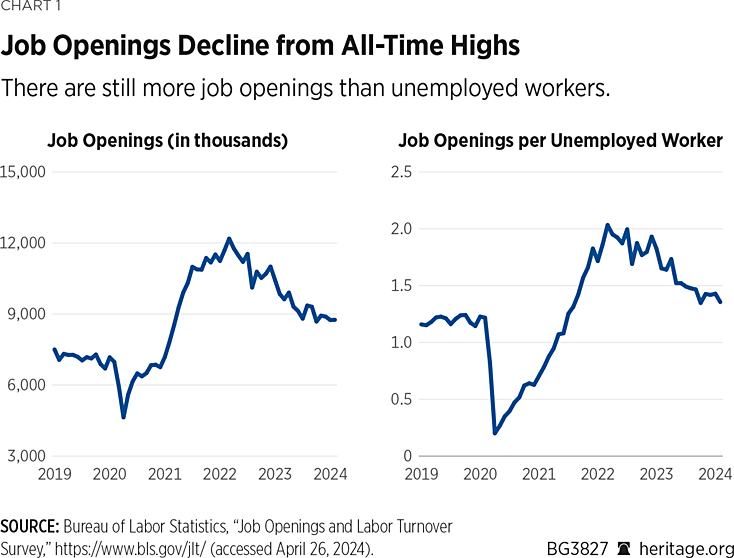
In March, a net 37 percentREF of all small businesses reported job openings that they could not fill.REF This marks the lowest level since January 2021. Inflation and labor continue to dominate small business concerns, with 25 percent of owners citing inflation as their single greatest concern, 18 percent citing labor quality, and 10 percent citing labor costs.REF A net 38 percent of small businesses reported raising compensation over the previous three months and a net 37 percent of businesses reported increasing their prices over the previous three months.REF
Uncertainty over the future appears to be a significant concern for small businesses. The NFIB’s small business optimism index fell to its lowest level since 2012 in March. A net negative 18 percent of business owners reported higher real sales volume over the past three months, meaning that 18 percent fewer business owners reported higher sales than reported lower sales. Businesses’ profit outlooks are weak, with 29 percent fewer businesses reporting positive profit trends than those reporting negative trends.
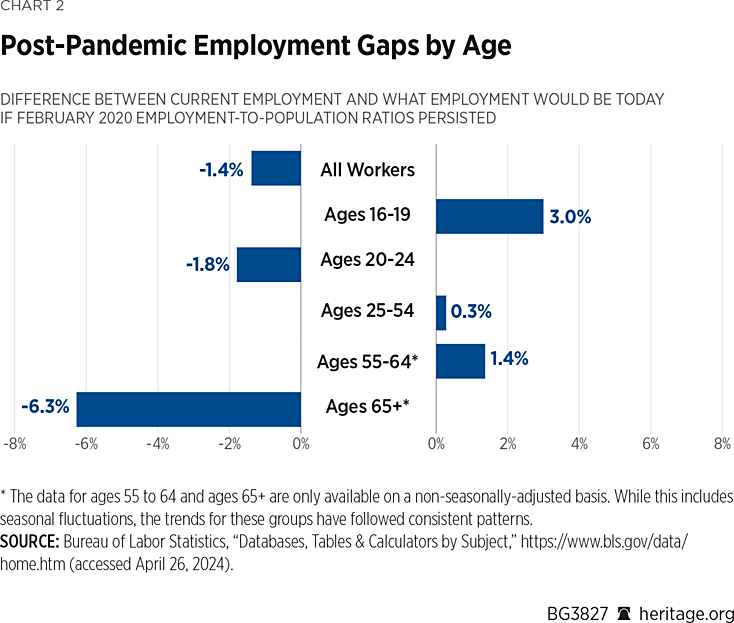
Employment Rates Unequally Low—Who Is In and Who Is Out?
Compared to pre-pandemic employment rates, 2.3 million fewer people are working today.REF This is an increase in the number of missing workers from a 1.9 million gap in March 2023. While total employment—based on the employment-to-population ratio—is 1.4 percent lower today than four years ago, that decline is not consistent across different demographics.
At the beginning of the pandemic, lower-wage workers and working women who were caregivers were more likely to have lost jobs or dropped out of the labor force. Also, older workers faced greater health concerns from COVID-19, which affected their employment. Once the economy started opening back up, teenagers disproportionately took advantage of increased job opportunities and higher wages.
Today, post-pandemic employment declines are concentrated among young people, workers ages 65 and older, and childless individuals. Employment gains are strongest for teens, older workers ages 55 to 64, and parents—particularly mothers—with young children at home.
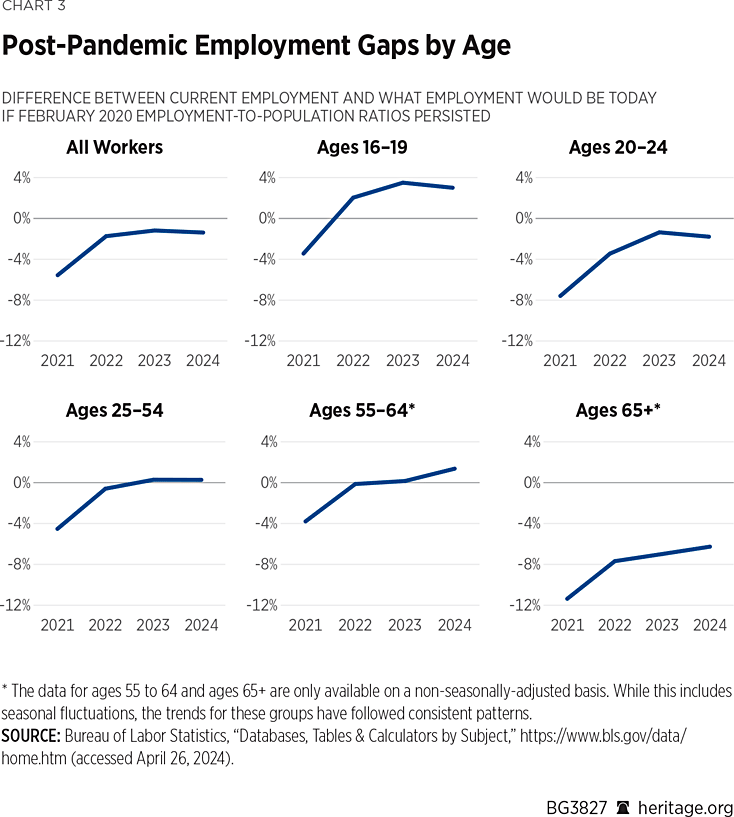
Large Employment Decline for Early Career Americans. Despite widespread availability of jobs across industries and skill levels, employers’ increasing willingness to train workers, and large increases in starting compensation, young workers have experienced the largest employment declines aside from workers ages 65 and above.REF Young workers between the ages of 20 and 24, who are traditionally just starting out their careers, have a troubling 1.8 percent employment gap, compared to a 0.3 percent employment gain for workers ages 25 to 54.REF
The decline in employment among individuals ages 20 to 24 cannot be explained by an increase in higher education attendance. Undergraduate employment in the fall of 2023 was 4.0 percent lower (754,000 fewer students) than in the fall of 2019, demonstrating an even more problematic rise in the number of young Americans who are neither working nor attending school.REF As education and work experience in the early years of adulthood are foundational for building careers and establishing effective work and lifestyle habits, this increase in apparent idleness or potentially harmful behaviors does not bode well for young Americans and the future workforce.
Reversing this decline in employment among workers who are just starting out their careers must include reducing work disincentives and expanding alternative education opportunities, along with other policies discussed in the final section, “Policies to Promote Better Education Options, Flexible Employment Opportunities, Rising Incomes, and Personal Well-Being.”
Ages 65+ Employment Decline. At the other end of the age spectrum, employment among the oldest Americans—ages 65 and up—declined sharply at the onset of the pandemic and remains 6.3 percent lower than four years ago.REF Interestingly, employment among Americans ages 55 to 64 is 1.4 percent higher today than prior to the pandemic.
Early in the pandemic, the decline in older Americans’ work was not surprising, considering their increased risks from COVID-19. Lasting declines can be explained by older Americans’ earlier-than-planned retirements due to rapid home prices growth that boosted their nest eggs. An economic analysis that examined home prices and labor force participation by age across metropolitan areas concluded that “the Great Resignation among older workers can be fully explained by increases in housing wealth.”REF
The rise in employment among workers ages 55 to 64 could be explained, in part, by an increase in remote and flexible work opportunities that have made it easier for many people—particularly the most tenured workers—to find employment that meets their desires and life circumstances. For older Americans, that could mean shifting from a traditional, in-office job to remote, independent work.
Male vs. Female Employment Gaps. Men’s employment is down 1.7 percent since February 2020, while women’s is down 1.1 percent. Looking just at workers in the 25-to-54 prime-age range, men’s prime-age employment is flat while women’s prime-age employment is up by 0.5 percent. This marks a significant change from the beginning of the pandemic when women were more likely to have lost jobs because they held a disproportionate share of service-sector jobs that were most affected by government shutdowns and were more likely to have stopped working to care for children. More flexible workplace policies, such as remote work options, alternative schedules, and new and expanded paid family leave benefits have almost certainly contributed to women’s relative employment gains. As discussed below under “Parents vs. Childless Workers,” it appears that shifts in the ways people work and live may have eased parents’ childcare struggles.
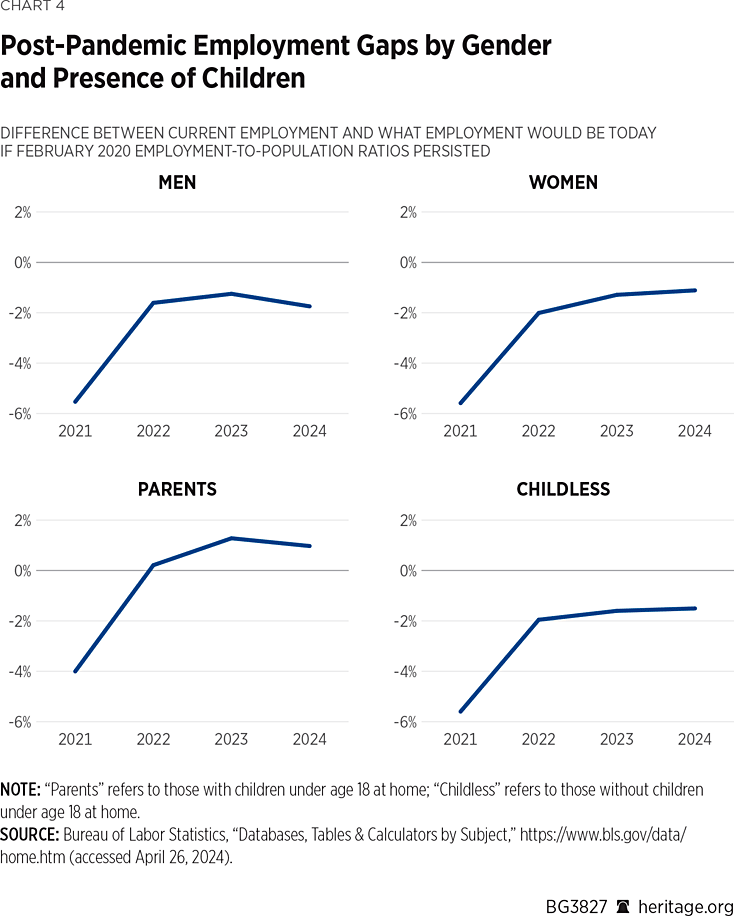
Parents vs. Childless Workers.REF Early in the pandemic, school and childcare closures significantly disrupted parents’—predominantly mothers’—ability to work. Moreover, pandemic-related concerns and restrictions in nursing homes and hospitals meant that more workers, predominantly women, were having to spend time caring for older family members. Yet, the data reveal that while these were significant concerns and struggles, they did not disproportionately affect women’s and parents’ employment.
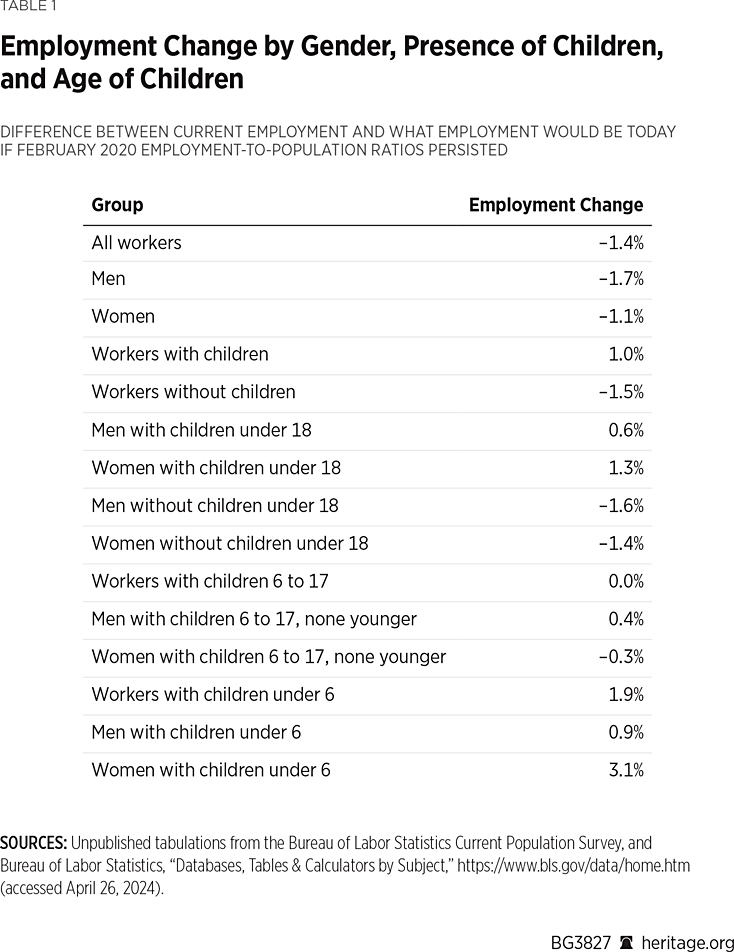
Table 1 provides a breakdown of the post-pandemic employment gaps for various groups of workers based on sex, as well as presence and age of children.REF
Despite the narrative that parents’ employment was disproportionately harmed by school and childcare closures, the data do not reveal that to have been the case, as parents have consistently experienced smaller employment gaps than those without children under 18 at home. Currently, workers without children have a 1.5 percent employment gap, while workers with children have an employment surplus of 1.0 percent.
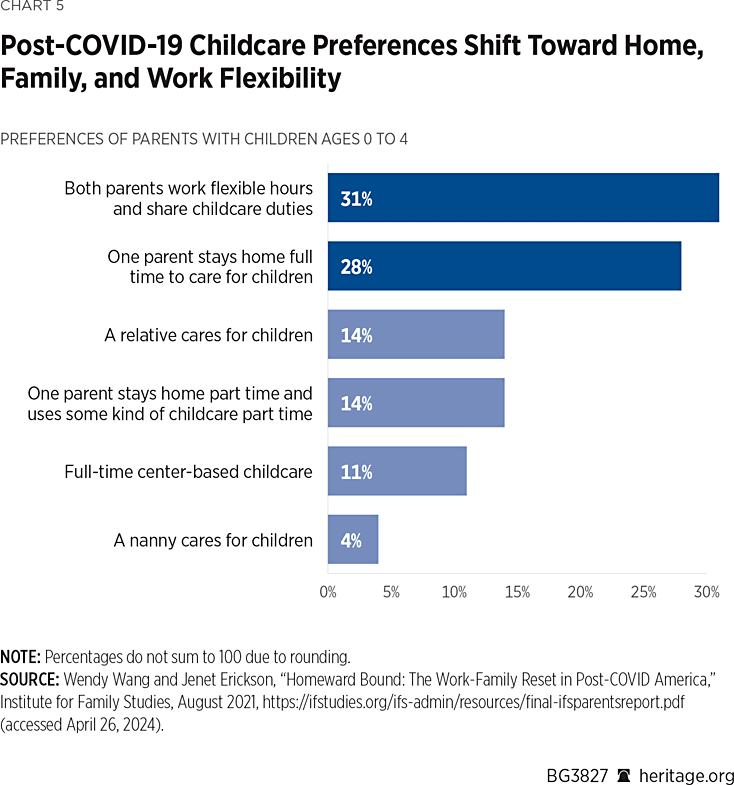
Throughout the pandemic, parents whose youngest child was under age six tended to experience smaller employment gaps than parents whose youngest child was between ages six and 17, or school-age. As of March 2024, employment of parents with children under age six had fully recovered and was 1.9 percent above February 2020 rates, while employment of parents with children ages six to 17 was unchanged. An increase in homeschooling since the pandemic could play a role in the employment of parents with children ages six to 17, which includes a 0.4 percent increase in employment among men and a 0.3 percent decrease in employment among women.
Of particular note is the fact that employment of women with children under the age of six is up by 3.1 percent, which is more than three times the next largest employment gain of 0.9 percent among men with children under the age of six.
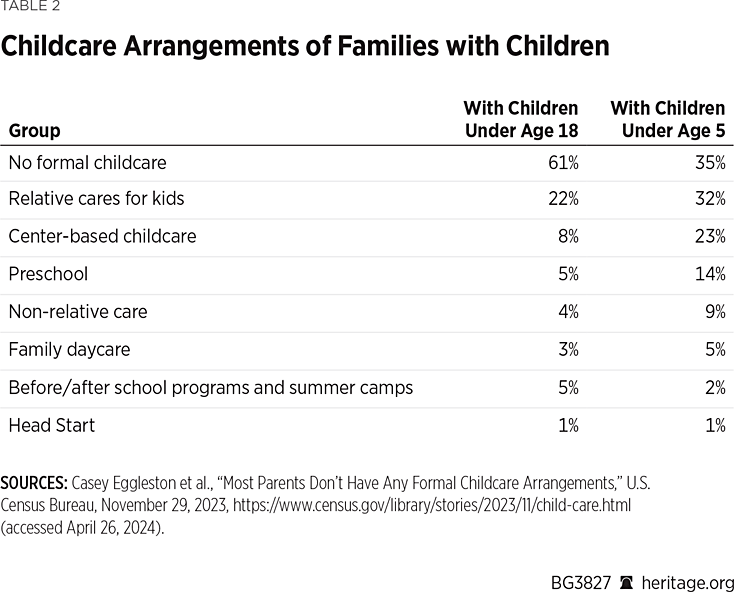
Multiple economic studies have shed light on the phenomenon of strong employment among parents of young children, essentially finding that childcare and family care struggles were real, but that they did not cause an excess decline in parents’ employment.REF Although it is too soon to know long-term trends, it appears that a silver lining of the pandemic has been to prompt workplace and lifestyle shifts that have eased childcare struggles. For example, increased remote and flexible work arrangements have allowed some parents to do away with formal childcare, and job and location changes have allowed more families to make flexible and family-based childcare arrangements.
A 2021 survey by the Institute for Family Studies asked parents of children under age five about their ideal work and childcare preferences. The most common preference—representing 31 percent of parents—was for parents to work flexible hours and share childcare duties.REF
According to the most recent Census survey (December 2022), two of every three parents with children under age five either have no formal childcare (35 percent) or have a relative caring for their children (32 percent).REF
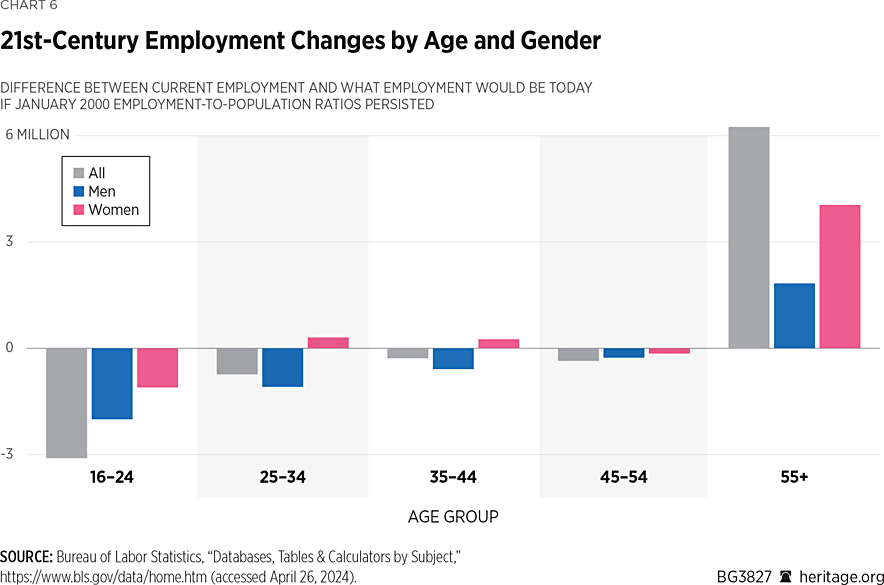
Longer-Term Trends in Employment
Since peaking at 64.7 percent at the turn of the 21st century, the U.S. employment-to-population ratio has declined significantly, to 60.3 percent today. Part of this decline is the result of population shifts, with the baby boom population moving into retirement years when employment naturally declines. Employment among the prime working-age population (ages 25 to 54) is down by 1.2 percentage points from its peak of 81.9 percent in 2000 (currently at 80.7 percent).
Despite the overall decline in employment, trends vary significantly based on age and gender. In particular, the drop in employment is entirely a younger-worker and male phenomenon. While older Americans’ employment declined significantly in the four years since the COVID-19 pandemic began, older workers have experienced huge gains in employment since the turn of the century.
As Chart 6 shows, overall employment gaps are heavily concentrated among workers under age 35 (a gap of 3.8 million) and, especially, among those under age 25 (a gap of 3.1 million). Meanwhile, there are currently 6.2 million more Americans ages 55 and older working today than in 2000. (The sums of age-based and gender-based gaps in employment do not equal total employment changes due to shifts in demographics over time. These gaps provide only a snapshot comparison.)
Broken down by gender, men have experienced declines in employment across all age groups except for those ages 55 and older. Women’s employment trends are mixed, with the youngest women experiencing a significant employment gap, prime-age women experiencing smaller and generally positive changes, and older women experiencing very large employment gains.
The enormous decline in employment among Americans under age 25, and men under age 35, is significant and troubling. While an increase in college enrollment can explain part of the decline in employment among young Americans, it does not explain it all, and the fact that women account for a rising share of college enrollment exacerbates the decline among young men compared to young women.REF
Potential Causes of Employment Declines
Many factors are contributing to a decline in employment in the U.S., both since the COVID-19 pandemic, and dating back to the employment peak of 2000. In addition to the aging of the baby boom population, other causes for employment declines include health factors, substance abuse and addiction, and cultural swings.
Physical and Mental Health. Despite improvements in medical technology and new pharmaceuticals that have saved lives and livelihoods in recent decades, and despite a shift toward less physically demanding work, Americans’ physical and mental health appears to be weighing on their ability to work. A 2018 study by the late Alan Krueger, economic advisor to President Barack Obama, found that physical and mental health limitations could be barriers to employment for about half of prime-age men not in the labor force.REF A 2023 survey by the Bipartisan Policy Center found that 57 percent of prime-age men who are not working and not looking for work cite their physical or mental health as the reason why they are not working.REF
Opioid Epidemic. Well before the COVID-19 pandemic, increased opioid use was considered a significant factor in declining labor force participation, particularly among men. Alan Kreuger’s 2017 study found that increased opioid prescriptions could have been responsible for 43 percent of the decline in male labor force participation and 25 percent of the decline in female labor force participation between 2000 and 2015.REF Building on Krueger’s work, an analysis by Ben Gitis and Isabel Soto of the American Action forum estimated that 919,400 prime-age workers were absent from the labor force and total employment was 878,200 lower in 2015 (than in 2000) as a result of opioid use.REF
The negative impact of opioids is almost certainly even larger today. Amid social isolation, anxiety, and limited access to physical and mental health care, substance abuse shot up during the COVID-19 pandemic.REF A study from the Federal Reserve Bank of Atlanta found that “increased substance abuse accounts for between 9 percent and 26 percent of the decline in prime-age labor force participation between February 2020 and June 2021.”REF Based on the 1.64 million-person decline in prime-age labor force participation over that period, this study suggests that the opioid epidemic accounted for the loss of between 148,000 and 426,000 prime-age workers from the labor force.REF Since the opioid epidemic affects workers across all ages, incomes, races, and geographic locations, it likely accounts for an even larger total decline in labor force participation. A December 2022 study by Isabella Hindley of the American Action Forum estimated that opioids were responsible for the loss of 1.3 million of a total of 6.3 million missing workers in 2021.REF
COVID-19 Health Impacts. Some people have experienced long-term health effects, so-called long COVID, that have prevented them from working for weeks, months, or even years after recovering from a COVID-19 infection. Evidence to date, however, suggests that COVID-19’s impacts on the workforce may be normal—perhaps even less impactful than similar, non-COVID-19 illnesses that present similar symptoms. A study published in the Journal of the American Medical Association found that 39.6 percent of patients that tested positive for COVID-19 reported residual symptoms three months after their initial infection, while 53.5 percent of patients who experienced similar symptoms but tested negative for COVID-19 reported residual symptoms three months after their initial infection.REF
To the degree that long COVID is affecting individuals’ ability to work, the good news is that most people recover from significant symptoms over time. Survey data from the Census Bureau and the National Center for Health Statistics show that 1.7 percent of adults currently report having significant activity limitations from long COVID.REF
Technology-Enabled Distractions. In the late 20th century, prime-age individuals without dependents had limited options for entertainment if they were not employed. Low-cost or no-cost leisure options were primarily watching scheduled TV shows or movies (there were no on-demand options), reading, or physical exercise. Today, the options for low-cost, on-demand entertainment are seemingly endless, from video gaming to movie streaming to social media to pornography. While studies are increasingly revealing the harmful effects of these activities on mental and even physical health, the immediate entertainment comes before the onset of long-term consequences.
A 2017 economic analysis, “Declining Work Hours and the Rise in Young Men’s Gaming,” estimated that increased recreational computer and video game use could explain a decline in the hours of work among young men of between 1.5 percent and 3 percent—30 hours to 60 hours per year.REF Given continued increases in recreational screen time, the impact is almost certainly larger today, and likely extends beyond young men.
Policies to Promote Better Education Options, Flexible Employment Opportunities, Rising Incomes, and Personal Well-Being
The workforce has still not recovered from flawed policy responses to the COVID-19 pandemic that discouraged work and caused excessive inflation. The recent decline in employment exacerbated a trend that began more than two decades ago, at the turn of the 21st century.
Work and earned success are fundamental components of human happiness and flourishing. And strong employment is crucial to a country’s well-being and endurance. Idle could-be workers generally fail to add to the economy, do not contribute to employment taxes, and often subtract from taxpayer resources. Personal and societal well-being, along with the federal government’s unsustainable fiscal outlook, necessitate better education, workforce, and tax policies to promote work.REF
The fact that employment gaps are concentrated in young and childless workers indicates that more alternative education and income opportunities are the solutions. Recent declines in employment among older Americans call for reducing barriers—including entitlement disincentives—to work. The strong rise in employment among parents—particularly mothers—with young children indicates that work flexibility is incredibly important, and that a costly new federal childcare entitlement would do little to increase employment.
To maximize employment, and simultaneously improve personal and societal well-being, policymakers need to remove government-imposed barriers to work and promote alternative education and flexible work opportunities. More than ever, massive and unsustainable federal spending—equal to almost $47,000 per household in 2023—demonstrates that a bigger government is not the solution. Rather than expanding the government’s influence over people’s lives, policymakers should expand education and work opportunities so that people have more resources and freedom to pursue what is best for them and their families.
Federal and state policymakers should:
- Make welfare work-oriented. Work is crucial to breaking cycles of poverty and dependence, which is why the primary goal of welfare should be to help individuals and families to thrive by empowering them, through work, to earn a living that allows them to make their own decisions and pursue their own goals. Welfare benefits for work-capable individuals must be tied to work.
- Improve and integrate welfare and workforce programs. Navigating the web of more than 90 federal welfare and workforce programs can be a nightmare, and too often, those seeking help end up trapped in welfare instead of being assisted into work and upward mobility. Utah’s successful “One Door” model has proven results in helping more Americans gain independence.REF If U.S. employment matched that of Utah, there would be 12.6 million more people working today.REF While many states would like to model their systems after Utah’s, federal rules currently prohibit them from doing so. Policymakers should amend the bipartisan Stronger Workforce for America Act so that all states—not just a few—can pursue Utah’s successful “One Door” welfare and workforce model.REF
- Replace failed federal job-training programs with more effective private, state, or local programs. The federal government spends billions of dollars each year on job-training programs that fail to provide workers with education and experience that helps them to find and retain jobs. The Workforce Investment ActREF and Job CorpsREF programs, for example, have had few positive employment effects.REF Instead of wasting taxpayer dollars and workers’ time on failed federal job-training programs, policymakers should allow workers to benefit from more effective employer-provided programs.REF
- Expand apprenticeship programs by ending the government monopoly. Apprenticeships are a proven alternative to degree programs, and a 2017 study estimated that the number of occupations commonly filled through apprenticeships could nearly triple, that the number of job openings filled through apprenticeships could expand eightfold, and that the occupations ripe for apprenticeship expansion could offer 20 percent higher wages than traditional apprenticeship occupations.REF Yet, the Biden Administration cancelled new and expanding Industry-Recognized Apprenticeship Programs, proposed an apprenticeship regulation that prohibits two of three existing Registered Apprenticeship Programs, and issued an executive order that will discourage companies from enacting their own, non-government-registered apprenticeship programs.REF In contrast to the Administration’s restrictions on apprenticeships, the Apprenticeship Freedom ActREF and the Training America’s Workforce ActREF would enable apprenticeships to expand across more industries, so that more young people can access on-the-job, paid education ending in a successful career.
- Reform accreditation to provide more post-secondary options. Current federal student loans and grants crowd out alternative, and often more effective, education options by limiting where students can use federal aid. The Higher Education Reform and Opportunity (HERO) Act would decouple federal student loans and grants from the federal accreditation process so that federal student aid could follow students to institutions and individual courses that are credentialed under a state’s accreditation system. This would allow students to have a more customized higher education experience, enter the labor market sooner, and reduce debt burdens.REF
- Phase out federal subsidies for higher education to unleash more effective, lower-cost alternatives. Employers report that college graduates increasingly lack the skills they need for the workplace. Federal subsidies for higher education inflate total costs, reduce the returns to higher education, and allow higher education institutions to get away with failing to provide relevant education. The U.S. Department of Education should stop adding gasoline to the fire and allow private financial institutions to pick up any gap in new loans and financial aid.
- Prohibit blanket student-loan “forgiveness.” The more than three-year pause on student-loan repayments reduced the incentive to work, and permanent forgiveness would encourage idleness and apathy in education and work pursuits. Congress should immediately prohibit the Biden Administration’s plansREF for back-door student-loan forgiveness, which would be inflationary, morally hazardous, regressive, and tip the scales away from more effective education alternatives.REF
- Review and eliminate unnecessary occupational licensure laws. In theory, licensure laws protect the public from unqualified or unscrupulous practitioners; in practice, many state licensure schemes act as cartels that protect incumbents from competition.REF Licensure laws are especially harmful to younger and lower-income individuals and the more than one in four American adults that have a criminal record.REF Requiring people to pay hefty fees and attend dozens or hundreds of hours of training before they can legally become barbers, bartenders, ballroom dance instructors, florists, or hair braiders limits work and income opportunities and drives up costs for consumers. State policymakers should review existing licensure laws and maintain only those that are truly necessary to protect consumers.
- Protect independent work by codifying a bright-line test for employees vs. independent contractors. Increasingly, many Americans want or need more flexibility than a traditional nine-to-five job provides. And economic studies show that flexibility increases the number of people who can work, as well as the hours that people work.REF More than half of the 64 million Americans who perform freelance work say that they are unable to work in a traditional job because of their personal health or their family caregiving needs.REF A Biden Administration rule that took effect on March 11, 2024, could drastically restrict independent work opportunities.REF A similar rule in California was estimated to reduce self-employment by 10.5 percent and total employment by 4.4 percent.REF The 21st Century Worker Act would provide clarity and future certainty by establishing a bright-line test, consistent across all federal laws, to determine who is an “employee” and who is an “independent contractor,” based primarily on how much control an employer exerts over a worker and with deference to workers’ preferred classifications in cases of ambiguity. Congress could also cancel the independent contractor rule by passing a Congressional Review Act (CRA) resolution of disapproval. Such resolutions have been introduced in both the Senate and the House, and the House passed a CRA resolution out of committee.
- Prevent overtime rules from costing workers flexibility and income. The Biden Administration finalized an overtime rule in April 2024 that will increase the salary threshold under which overtime rules generally apply by 65 percent, to about $59,000 at the start of 2025. Although the stated objective is to increase workers’ wages, the unintended consequences for workers will likely include lost flexibility, limited or no remote work capabilities, lost benefits, less predictable paychecks, and lower total compensation.REF Congress should amend the Fair Labor Standards Act to either clarify that it did not intend for the Department of Labor to create a salary threshold or to specify which type and level of salary threshold it intends. Congress could also cancel the overtime rule by passing a CRA resolution of disapproval.
- Allow accessible, affordable, and portable worker benefits. The average worker will change jobs 12 times throughout his career, but no one wants to roll over his 401(k) plan or change health insurance 12 times. Current policies make it difficult for workers to obtain portable benefits. Congress and the Administration should remove barriers to obtaining traditional workplace benefits, such as retirement savings and health and disability insurance, by making them portable from job to job.
- Eliminate Social Security’s retirement earnings test. Social Security’s misunderstood earnings test is perceived by workers as a 50 percent tax on their earnings, which causes people to work less, and thus earn less, than they otherwise would.REF Policymakers should eliminate this paternalistic and economically detrimental policy so that older Americans are not discouraged from working and earning more.
- Enact the Save Local Business Act to protect the franchising pathway to entrepreneurship. About 790,000 individually owned franchise operations employ 8.4 million workers across the U.S. In March 2024, a federal district court announced that it will vacate the Biden Administration’s “joint employer” rule that threatened to upend the franchise business model. While that prevents this particular rule from taking effect, administrative flip-flopping creates uncertainty and limits small business growth. The Save Local Business ActREF would prevent future flip-flopping by codifying the long-standing precedent that a person or entity is an employer of an employee only if that person or entity exercises direct and immediate control over the employee’s essential terms and conditions of employment.
- Prioritize workers’ choices about unionization. Congress should prioritize workers’ choices and respect unions’ resources by enacting the Workers Choice Act.REF This would eliminate forced unionization laws and “exclusive representation” laws so that workers do not have to pay for representation they do not want, and unions do not have to use their resources to represent workers who do not pay union dues.REF
- Enact the Employee Rights Act. This package of labor law modernizations, including many of the above recommendations, would help to increase employment by protecting existing and innovative work models, while respecting the rights of people to work in the ways that they prefer.REF
- Repeal the Davis–Bacon Actand end project labor agreement (PLA) requirements in federal construction projects. Even as the U.S. construction industry faces a workforce shortage of more than half a million workers, the Biden Administration implemented a 220-page Davis–Bacon Act rule that will limit the number of workers and companies that can work on federally funded construction projects. Even before this update, the Davis–Bacon Act was estimated to drive up federal construction costs by approximately 10 percent.REF Similarly, PLA requirements drive up construction costs and generally restrict federal construction projects to unionized workers that represent fewer than 12 percent of all construction workers.REF Congress should repeal the Davis–Bacon Act and PLAs. Absent full repeal, Congress should assign estimation of prevailing wage rates to the Bureau of Labor Statistics, which is capable of far more accurate wage calculations.REF
- Expand accessible, affordable childcare. Childcare is critical for parents of young children who want or need to work, but it needs to be the type of care that parents want. The federal Head Start program for children from lower-income homes has mediocre outcomes and limited hours of operation, which means that it is often not a viable childcare solution for working parents.REF Congress should allow parents to use federal childcare subsidies and Head Start funds at a provider of their choice.REF
- Remove barriers to work flexibility. Congress should enact the Working Families Flexibility ActREF so that lower-wage workers can choose to accrue paid time off in exchange for overtime work. Congress should also remove an unintentional barrier in the Fair Labor Standards Act that makes it harder for businesses to offer childcare benefits.REF
- Reduce government spending so inflation does not make workers poorer. The surge in federal government spending well beyond that necessitated by the COVID-19 pandemic undoubtedly fueled inflation. Over the past three years, inflation acted like a $16,900 tax, taking away the entirety of workers’ $11,500 nominal wage gains as well as taking away an additional $5,500 in purchasing power.REF To get ahead, workers need real income gains. Congress must immediately reverse recent spending expansions and quickly move on to reform unfunded entitlements to prevent further erosion of workers’ incomes through inflation and higher taxes needed to finance the federal government’s growing debt.
- Boost jobs and incomes by preventing tax increase. When employees and employers can keep more of what they earn, they will work more and invest more, leading to more jobs and higher productivity. The Tax Cuts and Jobs Act (TCJA) not only allowed workers to keep more of their earnings; it also enabled employers to make investments that led to more jobs and higher wages. A 2021 Heritage Foundation analysis found that the TCJA resulted in annual wages of more than $1,400 above trend.REF Policymakers should extend the pro-growth TCJA provisions and eliminate double taxes on investments that boost productivity and wages.REF
- Make saving easier through universal savings accounts (USAs). Personal savings provide a cushion for unemployment and can help to move people into better employment opportunities, including through additional education and entrepreneurial ventures. Personal savings are also important for family needs like education, childcare, family and medical leave, and unexpected expenses. The current structure that requires families to save across multiple tax-preferred accounts for different purposes makes it harder—especially for lower- and middle-income families—to save. When people can save in one place for all their needs, they are far more likely to do so.REF Congress should enact USAs so that workers can save money in a single, simple account for all their needs.
Conclusion
Work and earned success are fundamental components of human flourishing, and strong employment is crucial to a nation’s growth and endurance. IdleREF could-be workers generally do not add to the economy, do not contribute to employment taxes, and can subtract from taxpayer resources. Idleness, particularly at young ages, can have lifelong consequences. Economic studies show that even short-term unemployment can lead to a decline in physical and mental well-beingREF and reduced fertility,REF and that long-term unemployment tends to cause lower incomes, diminished career trajectories,REF and higher rates of disability insurance receipts.REF The decline in employment among young workers—including a loss of 3.1 million men under age 35 since 2000—is particularly troubling considering that these individuals have the majority of their lives ahead of them and should be climbing up the income ladder.
The labor market remains strong and is roughly on par with where it was before the pandemic. Yet, employers and workers face significant regulatory and fiscal headwinds. Small businesses report that inflation and labor quality and costs are their most important concerns, and employers’ optimism for the future is at an 11-year low. Workers face new regulations that could limit independent work options, take away workplace flexibility, and restrict apprenticeship options. Moreover, expiring tax cuts could limit workers’ future income growth.
Personal and societal well-being, along with the federal government’s unsustainable fiscal outlook necessitate better education, workforce, and tax policies to promote work.REF To maximize employment, and simultaneously improve personal and societal well-being, policymakers need to remove government-imposed barriers to work, alternative education, higher incomes, and more flexible work options.
More than ever, massive and unsustainable federal spending—equal to almost $47,000 per household in 2023—demonstrates that a bigger government is not the solution to helping individuals and families. Rather than expanding the government’s influence over people’s lives, policymakers should expand education and income opportunities so that people have more resources and freedom to pursue what is best for them and their families.
Rachel Greszler is Senior Research Fellow in Workforce and Public Finance in the Thomas A. Roe Institute for Economic Policy Studies at The Heritage Foundation.

